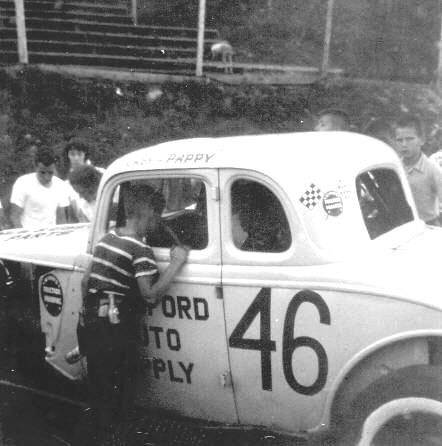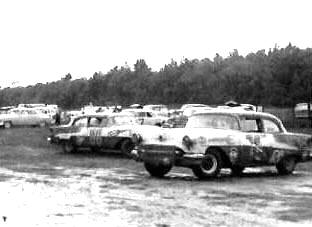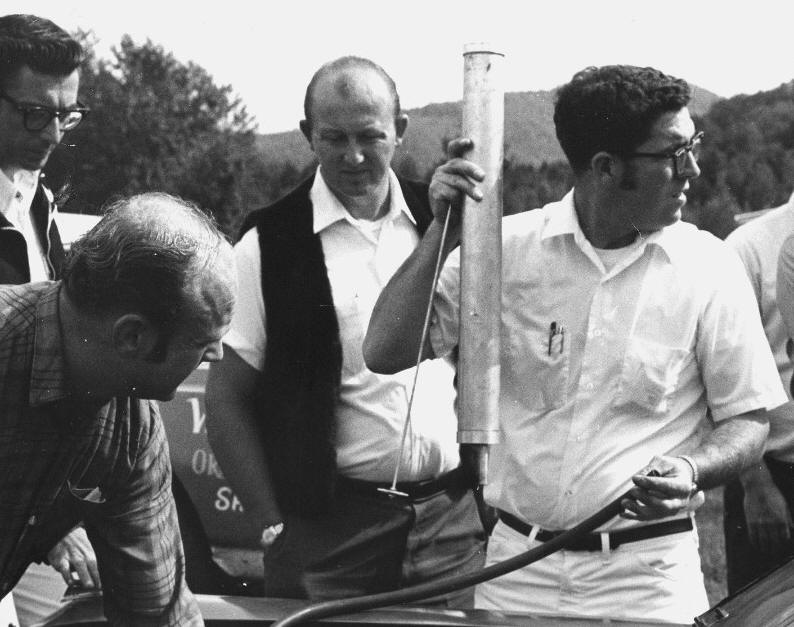This is how many people who were at races before Catamount remember Pat MCGrath. Here,he is posing with the
Fuller / Sam’s Flying A #56. Pat says his racing uniform here was the only one like it. [Courtesy of Chris Companion]
THE
BILL'S BACK IN TIME COLUMN PAGE
Copies of my column in Mark Thomas' "Racin'
Paper"
BILL’S BACK IN TIME
By Bill Ladabouche
Column 74 From Original Column 89
BILL’S BACK IN TIME
By Bill Ladabouche
THE BEST CALLS ARE THE ONES YOU DON’T EXPECT
I do not get too many phone calls at home, in view of the fact my wife runs a business and it seems like she is on the phone at least 40% of her day. I have gotten some great ones since I started doing this. Today, one of those great ones came [probably not coincidentally because the wife was not here].
It turned out to be Pat McGrath on the other end of the line. Almost apologetically, the voice sated the name and assumed he would have to explain who he was. I THINK NOT ! Besides being an important official Catamount Stadium and NASCAR official, Pat had been one of my first parents when I taught his daughter in a fourth grade room in Milton in 1969. What I got from Pat besides some great memories was some wonderful information that, in some cases, tied up loose ends from similar stories told by some of his contemporaries.
This is how many people who were at races before Catamount
remember Pat MCGrath. Here,he is posing with the
Fuller / Sam’s Flying A #56. Pat says his racing uniform here was the only one
like it. [Courtesy of Chris Companion]
Pat started racing at Malletts Bay in the mid to late 1950’s. It sounds as thought he would have raced only at the principal track, Walter Barcomb’s Colchester-Bayview Speedway because the other Colchester tracks had fallen by the wayside before 1955. Pat, as a very young man, was approached to drive a 1947 Chevrolet coupe, appropriately numbered 47, for George Hatch of C.P. Smith Tire.
After a run with that car, McGrath was made an offer that men only dreamed of in those days. A girl he was already sweet on offered to have her father build him a new race car to run at Malletts Bay. Carol Bessette, his future wife, got her father, Mark, to build McGrath a 1937 Chevy coupe, which would be lettered RU21 after a car he had seen at Stateline Speedway. I suspect the car he saw at Stateline was Link Petit’s car owned by Troy, New York’s John van Vricken. Pat goes on to say he was supposed to have a team mate, one Tippy Smart. But, when Smart struck him and roiled him most of the way down the front stretch at Malletts Bay, that team sort of disbanded.
The Van Vricken RU21, shown here at Empire Speedway with
Link Pettit, May have been
the inspiration for Pat’s second car. [Source Unknown]
About the time the RU21, Northern version, was being dismantled, Pat would receive another offer to pilot a car for someone else. Barney Fuller had built a 1934 Ford three window coupe, numbered 56 and sponsored by Sam’s Flying a – a gas station near Battery Park in Burlington, Vermont. This is the car most people think of when they think of Pat because it was the best and most widely – distributed photo of the diminutive driver. After running this car for a while, the McGrath’s had children, and Pat had to find a way to make his interest in racing pay off. Unfortunately, the first idea did not pay much.
Red Dooley [3 Jr.] sits out the window
and watches his team car [Wayne Chandler’s] burn at Otter Creek. Keeping a
safe distance is #5 Jack Anderson. The car in front of the big old #ABC is
probably Jim Hampton in another,
less flammable Hudson. [Courtesy of Cho Lee]
Pat had always sort of admired the powerful Hudson #3 of Wayne Chandler. McGrath also felt that sometimes the Chandler cars might have used a little more patient preparation, but he jumped at the chance he was given. Chandler had burned his hand removing the car from the radiator after a race. He asked Pat to drive the car and both men being none – too – tall, that seemed to be working out. Pat allows as how he had not even made it completely onto the track to get in line, when the big radiator on the Hudson shook loose, into the radiator and ended his dream ride. He was not particularly surprised when I mentioned that the only photo I had of that Chandler car showed it was on fire.
When he had given up driving , Pat was approached to do some flagging at Northfield, Vermont’s Dog River Speedway, about the time when the track was reaching the end of its life. The promoter, a little sawed-off X*!!&&, as Pat describes him, hired but never paid his flagger. By the time Pat was flagging, Ken Squier and the Cooley brothers [themselves former racers] had opened the flashy Thunder Road International Speedbowl, not far away, in Barre. T Road wanted no competition, so the Cooleys, who were pavers by trade, bought the gravel pit in front of Dog River and would not allow access through their property to the old fairgrounds track any more. End of story.

Kids check out the George Barber coupe of Pappy Forsythe
at Dog River, about the time
Pat would have been flagging there. [ Mike Gilbert Photo]
After the demise of Dog River, NASCAR opened up a track in a pasture near Vergennes, Vermont. Hi Monroe, the farmer, and Lee Tucker, a race car owner, had put together the plans for Otter Creek Speedway in the town of Waltham, in one of Monroe’s pastures. Pat, along with establish NASCAR flagmen Archie Blackadar and Bucky Barlow, swung the colors on the dirt birm beside the bumpy and dusty half mile in the first two years of the track, the two years it had NASCAR sanctions. Pat got to show the green to some of the Northeast’s leading sportsman chauffeurs of the day, like Kenny Shoemaker, Buck Holliday
Eventually, promoter C. J. Richards, whose car were making up more and more of the fields at Otter Creek, took over running the track and NASCAR was sent packing. This meant NASCAR personnel like McGrath, pit steward Kay Hanson, and others went out with it. The next time Pat would surface was when the new, state – of – the – art Catamount Stadium was built in his hometown of Milton, Vermont. Pat would become a tech inspector there, a job which would lead to bigger opportunities in the South.
McGrath had always been fascinated with the big-time racing since he had watched a Grand National at Airborne Speedway in the 1950’s. At that particular race, Lee Petty had won the race, but the human interest story was with Glen “Fireball” Roberts, whose car had been wrecked the night before at Fonda. Roberts was running for points and he could not arrange to borrow any competitor’s car. As it turned out, a fan stepped forward, Roberts took the man’s car, taped up the headlights, put a belt around the door post, and raced the car as carefully as he could, garnering needed points for the night. Happy driver; happier fan.

This small photo shows two Grand National Oldsmobiles in
the pits at that Airborne race.
[Bob Mackey Photo Courtesy of John Rock]
NASCAR had only recently built the massive Daytona International Speedway, and some of Pat’s connections made it possible for him to go down in the winter and join the legions of officials needed to run Speedweeks. Pat would help inspect the hundreds of cars that were brought into Daytona from all over the country. Some of these cars were not up to NASCAR standards and could have caused some serious safety issues in those early days. Later on, Pat and Carol would also meet the NASCAR Grand American touring cars and remain with them through their 9 – track Northern trip.

Roger Paquette, a fellow named Bushey, and other members
of Pat’s tech crew cube a car
at Catamount around 1970. [Courtesy of Cho Lee].
Pat has experienced the highs and lows of the sport. Clyde Yarnell, a fellow scoutmaster with McGrath, had the agonizing experience of striking and killing a drunken spectator at a race in Vermont. McGrath would have know Don MacTavish from Catamount days and then would have been there when Don was kicked at Daytona in that fateful Mercury later model sportsman. He also got into racing on the ground floor when it was more fun and when some people could actually make a living doing it. He has been around sprinters, midgets, late models and coupes. Carol would be a scorekeeper and he would inspect. Like so many others of his time, Pat can look back fondly on his time in racing.
Pat receives an award from Archie Blackadar to commemorate
his service at
Catamount. [Courtesy of Chris Companion]
Return
to the Main Page
Return to the Main News Page
Return to the Columns Link Page
Return to the All Links Page